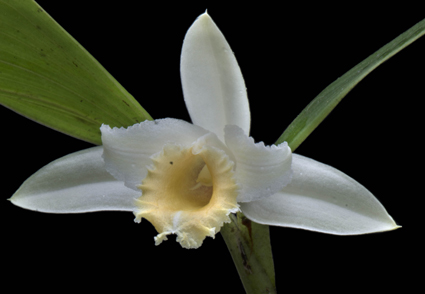Abstract
In Panama, the Orchidaceae comprise 187 genera, of which one of the most conspicuous is Sobralia. The flowers of Sobralia are mostly ephemeral but colorful, often fragrant, and of variable sizes. Despite being a prominent group, its taxonomy is still underdeveloped in most neotropical countries. To continue with taxonomic studies in the Orchidaceae of Panama, we investigated a species of Sobralia, which differs from any recorded species of the genus. We documented the species with digital images and compared it with morphologically similar taxa. This paper describes and illustrates a new Sobralia from the Bosque Protector Palo Seco in the Fortuna area, Panama. Sobralia rinconiana differs from all other species recorded in Panama by the combination of a large plant size that reaches up to 120 cm high and the larger and broader, elliptical-lanceolate leaves (30–35 × 14–16 cm). Sobralia rinconiana is most similar to S. carazoi but differs in the spreading flowers with reflexed petals and the infundibuliform, cream-yellow lip, the wider, longer sepals and petals, and the longer, suberect column. The accurate estimate of the number of Sobralia species in Panama is still uncertain. Its diversity may increase as new areas are explored or species complexes are resolved.
References
<p>Baranow, P. & Dudek, M. (2018) <em>Sobralia fugax</em> (Orchidaceae: Sobraliae)—a new species from Colombia described on the basis of morphological study and phylogenetic analyses. <em>Phytotaxa</em> 372 (4): 273–282. https://doi.org/10.11646/phytotaxa.372.4.4</p>
<p>Bogarín, D., Serracín, Z., Samudio, Z., Rincón, R. & Pupulin, F. (2014) An updated checklist of the Orchidaceae of Panama. <em>Lankesteriana</em> 14 (3): 1–364. https://doi.org/10.1017/CBO9781107415324.004</p>
<p>Coster, C. (1926) Periodische Bluteerscheinungen in den Tropen. <em>Annales Du Jardin Botanique de Buitenzorg</em> 35: 125–162.</p>
<p>Dalling, J.W. & Turner, B.L. (2021) <em>Fortuna Forest Reserve, Panama Interacting Effects of Climate and Soils on the Biota of a Wet Premontane Tropical Forest</em>. Smithsonian Contributions to Botany, Washington D.C., 303 pp. https://doi.org/10.5479/si.14315990</p>
<p>Dressler, R.L. (1995) New orchid species from Costa Rica<em>. Novon</em> 5 (2): 140–145. https://doi.org/10.2307/3392235</p>
<p>Dressler, R.L. (2001) Two Sobralias. <em>Sobralia chrysostoma </em>is described and the identity of <em>Sobralia leucoxantha</em> is resolved. <em>Orchids</em> 70 (8): 750–770.</p>
<p>Dressler, R.L. (2002) The major sections and groups within <em>Sobralia</em>, with four new species from Panama and Costa Rica<em>, S. crispissima, S. gloriana, S. mariannae and S. nutans. Lankasteriana</em> 5: 9–15. https://doi.org/10.15517/lank.v2i3.23088</p>
<p>Dressler, R.L. (2005) Six more new species of <em>Sobralia</em> from Panama. <em>Orchids</em> 74 (12): 937–941.</p>
<p>Dressler, R.L. (2011) ¿Las sobralias se pueden clasificar?—el complejo de <em>Sobralia warszewiczii</em>. <em>Lankesteriana</em> 11 (3): 239–243. https://doi.org/10.15517/lank.v11i3.18278</p>
<p>Dressler, R.L., Acuña, M. & Pupulin, F. (2016) <em>Sobralia turrialbina</em> (Orchidaceae: Sobralieae): long cultivated and now described. <em>Harvard Papers in Botany</em> 21: 251–161. https://doi.org/10.3100/hpib.v21iss2.2016.n10</p>
<p>Dressler, R.L. & Bogarín, D. (2009) Some new Sobraliae from Costa Rica and Panama. <em>Lankesteriana</em> 9 (3): 475–486. https://doi.org/10.15517/lank.v0i0.12109</p>
<p>Dressler, R.L. & Bogarín, D. (2011) <em>Sobralia sanctorum </em>and<em> Sobralia purpurella. Orchids</em> 80 (5): 307–310.</p>
<p>Dressler, R.L. & Bogarín, D. (2007) Two attractive new species of <em>Sobralia</em> from Panama. <em>Orchids</em> 76 (9): 696–701.</p>
<p>Kolanowska, M. (2014) <em>Orchids of the Darién Gap</em>. Koeltz Botanical Books, Germany, 348 pp.</p>
<p>Lindley, J. & Linden, J.J. (1846) <em>Orchidaceae Lindenianae, Notes upon a collection of orchids formed in Colombia and Cuba.</em> Bradbury & Evans, London, viii + 28 pp. https://doi.org/10.5962/bhl.title.66687</p>
<p>Ortiz, O.O., Flores, R., McPherson, G., Carrión, J.F., Campos-Pineda, E. & Baldini, R.M. (2019) Additions to the flora of Panama, with comments on plant collections and information gaps. <em>Check List</em> 15 (4): 601–627. https://doi.org/10.15560/15.4.601</p>
<p>Reichenbach, H.G. (1852) Neue Orchideen der Expedition des Herrn J. de Warszewicz<em>. Botanische Zeitung (Berlin) </em>10: 689–698.</p>
<p>Reichenbach, H.G. (1866) <em>Beitrage zu einer orchideenkunde Central-Amerika’s.</em> Druck von T.G. Meissner, Hamburg, 176 pp. https://doi.org/10.5962/bhl.title.60976</p>
<p>Rolfe, R.A. (1909) XI. New orchids: decade 33. <em>Bulletin of Miscellaneous Information, Royal Botanic Gardens, Kew</em> 1909 (2): 61–66. https://doi.org/10.2307/4111609</p>
<p>Ruiz, H. & Pavón, J. (1794) <em>Flora peruvianae et chilensis prodromus</em>. Imprenta A. de Sancha, Madrid, 153 pp.</p>
<p>Schweinfurth, C. (1938) New orchids from Central America<em>. Botanical Museum Leaflets (Harvard University)</em> 5 (6): 89–91. https://doi.org/10.5962/p.168610</p>
<p>Silvera, K. (2021) The Orchids of Fortuna, Panama: a checklist of photosynthetic pathways, growth habitat, and resource acquisition. <em>In</em>: Dalling, J.W. & Turner, B.L. (Eds.) <em>Fortuna Forest Reserve, Panama Interacting Effects of Climate and Soils on the Biota of a Wet Premontane Tropical Forest</em>. Smithsonian Contributions to Botany, Washington D.C., pp. 213–236.</p>
<p>Swartz, O. (1799) <em>Dendrobium crumenatum</em> Sw. <em>Journal für die Botanik (Schrader)</em> 2: 237.</p>
<p>Williams, L.O. (1946) Flora of Panama. Part III Fascicle II: Orchidaceae. <em>Annals of the Missouri Botanical Garden</em> 33 (1): 1–140. https://doi.org/10.2307/2394519</p>


